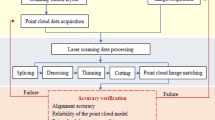Abstract
Terrestrial laser scanning is a popular methodology that is used frequently in the process of documenting historical buildings and cultural heritage. The historical peninsula region sprawls over an area of approximately 1,500 ha and is one of the main aggregate areas of the historical buildings in Istanbul. In this study, terrestrial laser scanning and close range photogrammetry techniques are integrated into each other to create a 3D city model of this part of Istanbul, including some of the buildings that represent the most brilliant areas of Byzantine and Ottoman Empires. Several terrestrial laser scanners with their different specifications were used to solve various geometric scanning problems for distinct areas of the subject city. Photogrammetric method was used for the documentation of the facades of these historical buildings for architectural purposes. This study differentiates itself from the similar ones by its application process that focuses on the geometry, the building texture, and density of the study area. Nowadays, the largest-scale studies among 3D modeling studies, in terms of the methodology of measurement, are urban modeling studies. Because of this large scale, the application of 3D urban modeling studies is executed in a gradual way. In this study, a modeling method based on the facades of the streets was used. In addition, the complimentary elements for the process of modeling were combined in several ways. A street model was presented as a sample, as being the subject of the applied study. In our application of 3D modeling, the modeling based on close range photogrammetry and the data of combined calibration with the data of terrestrial laser scanner were used in a compatible way. The final work was formed with the pedestal data for 3D visualization.
Similar content being viewed by others
References
Andreetto, M., Brusco, N., & Cortelazzo, G. (2003). Automatic 3D modeling of palatal plastercasts. In IEEE 3-D digital imaging and modeling (pp. 132–138).
Destruel, C., & Valorge, C. (2004). Automatic 3D rendering of high resolution space images. In ISPRS 2004 proceedings commission V.
Ergün, B. (2007). Creating a 3D urban model by terrestrial laser scanners and photogrammetry techniques: A case study on the historical peninsula of İstanbul. O3A: Optics for Arts, Architecture, and Archaeology 6618.
Früh, C., & Zakhor, A. (2003). Constructing 3D city models by merging ground-based and airborne views. In IEEE computer graphics and applications (pp. 52–61) (special issue Nov/Dec).
Früh, C., & Zakhor, A. (2004). An automated method for large-scale, ground-based city model acquisition. International Journal of Computer Vision, 60, 5–24. doi:10.1023/B:VISI.0000027787.82851.b6.
Kern, F. (2001). Supplementing laser scanner geometric data with photogrammetric images for modeling. In The CIPA international archives for documentation of cultural heritage, 18–21 September (Vol. XVIII, pp. 454–461). Postdam, Germany.
Kersten, Th. (2004). 3D acquisition, modelling and visualization of north German castles by digital architectural photogrammetry. In ISPRS 2004 proceedings commission V.
ShiuanFu, C., & Jie, S. (2004). 3D building reconstruction from unconstructed distinct points. In ISPRS 2004 proceedings commission III.
Author information
Authors and Affiliations
Corresponding author
Rights and permissions
About this article
Cite this article
Ergun, B., Sahin, C., Baz, I. et al. A case study on the historical peninsula of Istanbul based on three-dimensional modeling by using photogrammetry and terrestrial laser scanning. Environ Monit Assess 165, 595–601 (2010). https://doi.org/10.1007/s10661-009-0971-0
Received:
Accepted:
Published:
Issue Date:
DOI: https://doi.org/10.1007/s10661-009-0971-0




